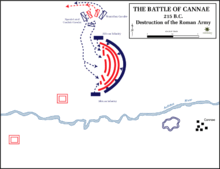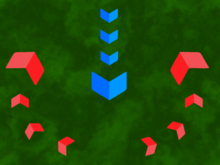- Pincer movement
-
 The destruction of the Roman army (red) by Carthaginians under Hannibal (blue) at the Battle of Cannae.
The destruction of the Roman army (red) by Carthaginians under Hannibal (blue) at the Battle of Cannae.
The pincer movement or double envelopment is a military maneuver. The flanks of the opponent are attacked simultaneously in a pinching motion after the opponent has advanced towards the center of an army which is responding by moving its outside forces to the enemy's flanks, in order to surround it. At the same time, a second layer of pincers attacks on the more extreme flanks, so as to prevent any attempts to reinforce the target unit. Most infantry combat, on every scale, is based in some fashion on this military tactic and it is commonly used by aircraft as well.
Contents
Description
A double envelopment by definition leads to the attacking army facing the enemy in front, on both flanks, and in the rear. If the attacking pincers link up in the enemy's rear, the enemy is encircled. Such battles often end in surrender or destruction of the enemy force, although the encircled force can attempt a breakout, attacking the encirclement from the inside in order to escape, or a friendly external force can attack from the outside to open up an escape route for the encircled force.
History
Sun Tzu in The Art of War speculated on the maneuver, but advised against trying it, feeling that an army would likely run first before the move could be completed. He argued that it was best to allow the enemy a path to escape, as the target army would fight with more ferocity when completely surrounded.
The maneuver may have been used at the Battle of Marathon in the 5th century BC.
Hannibal executed this maneuver at the Battle of Cannae in 216 BC. This is viewed by military historians as one of the greatest battlefield maneuvers in history, and is cited as the first successful use of the pincer movement to be recorded in detail.[1]
It was also later effectively used by Khalid ibn al-Walid at the Battle of Walaja in 633, by Alp Arslan at the Battle of Manzikert in 1071 under name of Crescent Tactic, at Battle of Mohács by Süleyman the Magnificent in 1526 and by Field Marshal Carl Gustav Rehnskiöld at the Battle of Fraustadt in 1706.
It was also used by Daniel Morgan at the Battle of Cowpens in 1781 in South Carolina. Morgan's cunning plan at Cowpens is widely considered to be the tactical masterpiece of the American Revolutionary war.
A version of this maneuver was a standard tactic used by Shaka.A rudimentary form of this maneuver was also employed by Genghis Khan, known colloquially as the 'horns' tactic. In this case, two enveloping flanks of horsemen surrounded the enemy although they usually remained unjoined, leaving the enemy an escape route to the rear, as described above. This was key to many of Genghis' early victories over other Mongolian tribes.
See also
- Battle of Marathon
- Battle of the Trebia
- Battle of Cannae
- Battle of Walaja
- Battle of Manzikert
- Battle of Cowpens
- Battle of Fraustadt
- Battle of Hansan Island
- Battle of San Lorenzo
- Second Bull Run (1862)
- Battle of Tannenberg (1914)
- Battle of Khalkhin Gol (operational envelopment)
- Battle of Stalingrad (strategic envelopment)
- Manchurian Strategic Offensive Operation
- Six-Day War
- Encirclement
- Flanking maneuver
- Operation Postern
References
- ^ "Appendix C" (PDF file —viewed as cached HTML—). The complete book of military science, abridged. http://www.google.com/search?q=cache:RHxcfedl0_cJ:www.28thmasscob.org/reconac.PDF+%22Battle+of+Cannae%22+%22recorded+in+detail%22&hl=en&gl=us&ct=clnk&cd=3. Retrieved march 25, 2006.
Further reading
- U.S. Army training manual diagram of different modes of attack, including double envelopment
- GlobalSecurity.org essay with a section on envelopments
- Academic paper on military diagramming with diagram of a double envelopment
- Map of Georgy Zhukov's double envelopment at the battle of Stalingrad
Categories:- Maneuver tactics
- Military strategy
Wikimedia Foundation. 2010.

